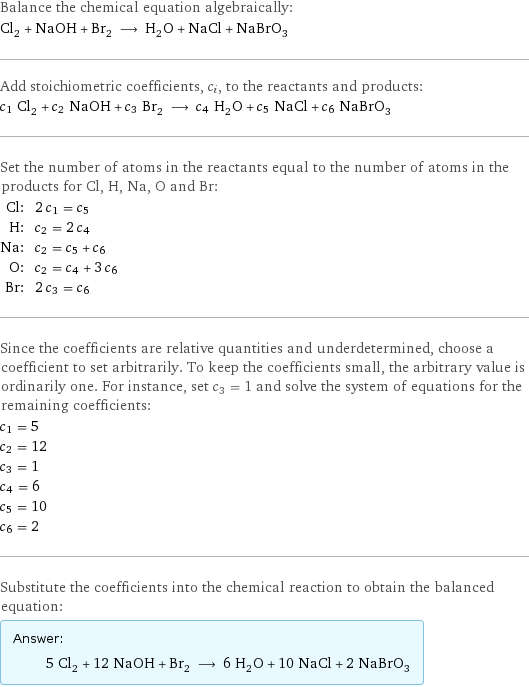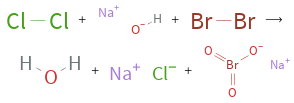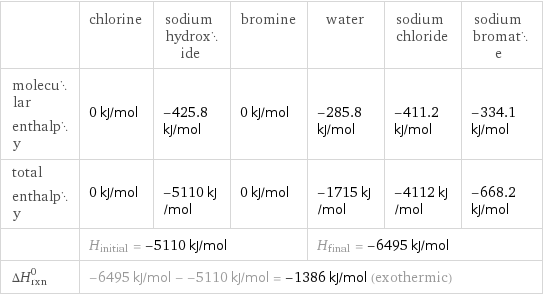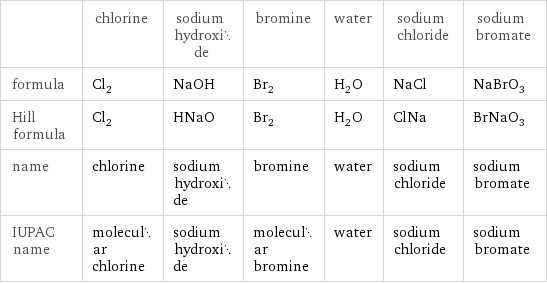Input interpretation

Cl_2 chlorine + NaOH sodium hydroxide + Br_2 bromine ⟶ H_2O water + NaCl sodium chloride + NaBrO_3 sodium bromate
Balanced equation

Balance the chemical equation algebraically: Cl_2 + NaOH + Br_2 ⟶ H_2O + NaCl + NaBrO_3 Add stoichiometric coefficients, c_i, to the reactants and products: c_1 Cl_2 + c_2 NaOH + c_3 Br_2 ⟶ c_4 H_2O + c_5 NaCl + c_6 NaBrO_3 Set the number of atoms in the reactants equal to the number of atoms in the products for Cl, H, Na, O and Br: Cl: | 2 c_1 = c_5 H: | c_2 = 2 c_4 Na: | c_2 = c_5 + c_6 O: | c_2 = c_4 + 3 c_6 Br: | 2 c_3 = c_6 Since the coefficients are relative quantities and underdetermined, choose a coefficient to set arbitrarily. To keep the coefficients small, the arbitrary value is ordinarily one. For instance, set c_3 = 1 and solve the system of equations for the remaining coefficients: c_1 = 5 c_2 = 12 c_3 = 1 c_4 = 6 c_5 = 10 c_6 = 2 Substitute the coefficients into the chemical reaction to obtain the balanced equation: Answer: | | 5 Cl_2 + 12 NaOH + Br_2 ⟶ 6 H_2O + 10 NaCl + 2 NaBrO_3
Structures

+ + ⟶ + +
Names

chlorine + sodium hydroxide + bromine ⟶ water + sodium chloride + sodium bromate
Reaction thermodynamics
Enthalpy

| chlorine | sodium hydroxide | bromine | water | sodium chloride | sodium bromate molecular enthalpy | 0 kJ/mol | -425.8 kJ/mol | 0 kJ/mol | -285.8 kJ/mol | -411.2 kJ/mol | -334.1 kJ/mol total enthalpy | 0 kJ/mol | -5110 kJ/mol | 0 kJ/mol | -1715 kJ/mol | -4112 kJ/mol | -668.2 kJ/mol | H_initial = -5110 kJ/mol | | | H_final = -6495 kJ/mol | | ΔH_rxn^0 | -6495 kJ/mol - -5110 kJ/mol = -1386 kJ/mol (exothermic) | | | | |
Gibbs free energy

| chlorine | sodium hydroxide | bromine | water | sodium chloride | sodium bromate molecular free energy | 0 kJ/mol | -379.7 kJ/mol | 0 kJ/mol | -237.1 kJ/mol | -384.1 kJ/mol | -242.6 kJ/mol total free energy | 0 kJ/mol | -4556 kJ/mol | 0 kJ/mol | -1423 kJ/mol | -3841 kJ/mol | -485.2 kJ/mol | G_initial = -4556 kJ/mol | | | G_final = -5749 kJ/mol | | ΔG_rxn^0 | -5749 kJ/mol - -4556 kJ/mol = -1192 kJ/mol (exergonic) | | | | |
Equilibrium constant
![Construct the equilibrium constant, K, expression for: Cl_2 + NaOH + Br_2 ⟶ H_2O + NaCl + NaBrO_3 Plan: • Balance the chemical equation. • Determine the stoichiometric numbers. • Assemble the activity expression for each chemical species. • Use the activity expressions to build the equilibrium constant expression. Write the balanced chemical equation: 5 Cl_2 + 12 NaOH + Br_2 ⟶ 6 H_2O + 10 NaCl + 2 NaBrO_3 Assign stoichiometric numbers, ν_i, using the stoichiometric coefficients, c_i, from the balanced chemical equation in the following manner: ν_i = -c_i for reactants and ν_i = c_i for products: chemical species | c_i | ν_i Cl_2 | 5 | -5 NaOH | 12 | -12 Br_2 | 1 | -1 H_2O | 6 | 6 NaCl | 10 | 10 NaBrO_3 | 2 | 2 Assemble the activity expressions accounting for the state of matter and ν_i: chemical species | c_i | ν_i | activity expression Cl_2 | 5 | -5 | ([Cl2])^(-5) NaOH | 12 | -12 | ([NaOH])^(-12) Br_2 | 1 | -1 | ([Br2])^(-1) H_2O | 6 | 6 | ([H2O])^6 NaCl | 10 | 10 | ([NaCl])^10 NaBrO_3 | 2 | 2 | ([NaBrO3])^2 The equilibrium constant symbol in the concentration basis is: K_c Mulitply the activity expressions to arrive at the K_c expression: Answer: | | K_c = ([Cl2])^(-5) ([NaOH])^(-12) ([Br2])^(-1) ([H2O])^6 ([NaCl])^10 ([NaBrO3])^2 = (([H2O])^6 ([NaCl])^10 ([NaBrO3])^2)/(([Cl2])^5 ([NaOH])^12 [Br2])](../image_source/07be3f7dac7430eb94ff72ced4f24a58.png)
Construct the equilibrium constant, K, expression for: Cl_2 + NaOH + Br_2 ⟶ H_2O + NaCl + NaBrO_3 Plan: • Balance the chemical equation. • Determine the stoichiometric numbers. • Assemble the activity expression for each chemical species. • Use the activity expressions to build the equilibrium constant expression. Write the balanced chemical equation: 5 Cl_2 + 12 NaOH + Br_2 ⟶ 6 H_2O + 10 NaCl + 2 NaBrO_3 Assign stoichiometric numbers, ν_i, using the stoichiometric coefficients, c_i, from the balanced chemical equation in the following manner: ν_i = -c_i for reactants and ν_i = c_i for products: chemical species | c_i | ν_i Cl_2 | 5 | -5 NaOH | 12 | -12 Br_2 | 1 | -1 H_2O | 6 | 6 NaCl | 10 | 10 NaBrO_3 | 2 | 2 Assemble the activity expressions accounting for the state of matter and ν_i: chemical species | c_i | ν_i | activity expression Cl_2 | 5 | -5 | ([Cl2])^(-5) NaOH | 12 | -12 | ([NaOH])^(-12) Br_2 | 1 | -1 | ([Br2])^(-1) H_2O | 6 | 6 | ([H2O])^6 NaCl | 10 | 10 | ([NaCl])^10 NaBrO_3 | 2 | 2 | ([NaBrO3])^2 The equilibrium constant symbol in the concentration basis is: K_c Mulitply the activity expressions to arrive at the K_c expression: Answer: | | K_c = ([Cl2])^(-5) ([NaOH])^(-12) ([Br2])^(-1) ([H2O])^6 ([NaCl])^10 ([NaBrO3])^2 = (([H2O])^6 ([NaCl])^10 ([NaBrO3])^2)/(([Cl2])^5 ([NaOH])^12 [Br2])
Rate of reaction
![Construct the rate of reaction expression for: Cl_2 + NaOH + Br_2 ⟶ H_2O + NaCl + NaBrO_3 Plan: • Balance the chemical equation. • Determine the stoichiometric numbers. • Assemble the rate term for each chemical species. • Write the rate of reaction expression. Write the balanced chemical equation: 5 Cl_2 + 12 NaOH + Br_2 ⟶ 6 H_2O + 10 NaCl + 2 NaBrO_3 Assign stoichiometric numbers, ν_i, using the stoichiometric coefficients, c_i, from the balanced chemical equation in the following manner: ν_i = -c_i for reactants and ν_i = c_i for products: chemical species | c_i | ν_i Cl_2 | 5 | -5 NaOH | 12 | -12 Br_2 | 1 | -1 H_2O | 6 | 6 NaCl | 10 | 10 NaBrO_3 | 2 | 2 The rate term for each chemical species, B_i, is 1/ν_i(Δ[B_i])/(Δt) where [B_i] is the amount concentration and t is time: chemical species | c_i | ν_i | rate term Cl_2 | 5 | -5 | -1/5 (Δ[Cl2])/(Δt) NaOH | 12 | -12 | -1/12 (Δ[NaOH])/(Δt) Br_2 | 1 | -1 | -(Δ[Br2])/(Δt) H_2O | 6 | 6 | 1/6 (Δ[H2O])/(Δt) NaCl | 10 | 10 | 1/10 (Δ[NaCl])/(Δt) NaBrO_3 | 2 | 2 | 1/2 (Δ[NaBrO3])/(Δt) (for infinitesimal rate of change, replace Δ with d) Set the rate terms equal to each other to arrive at the rate expression: Answer: | | rate = -1/5 (Δ[Cl2])/(Δt) = -1/12 (Δ[NaOH])/(Δt) = -(Δ[Br2])/(Δt) = 1/6 (Δ[H2O])/(Δt) = 1/10 (Δ[NaCl])/(Δt) = 1/2 (Δ[NaBrO3])/(Δt) (assuming constant volume and no accumulation of intermediates or side products)](../image_source/ba0160357109adb36279790e31a1a9f2.png)
Construct the rate of reaction expression for: Cl_2 + NaOH + Br_2 ⟶ H_2O + NaCl + NaBrO_3 Plan: • Balance the chemical equation. • Determine the stoichiometric numbers. • Assemble the rate term for each chemical species. • Write the rate of reaction expression. Write the balanced chemical equation: 5 Cl_2 + 12 NaOH + Br_2 ⟶ 6 H_2O + 10 NaCl + 2 NaBrO_3 Assign stoichiometric numbers, ν_i, using the stoichiometric coefficients, c_i, from the balanced chemical equation in the following manner: ν_i = -c_i for reactants and ν_i = c_i for products: chemical species | c_i | ν_i Cl_2 | 5 | -5 NaOH | 12 | -12 Br_2 | 1 | -1 H_2O | 6 | 6 NaCl | 10 | 10 NaBrO_3 | 2 | 2 The rate term for each chemical species, B_i, is 1/ν_i(Δ[B_i])/(Δt) where [B_i] is the amount concentration and t is time: chemical species | c_i | ν_i | rate term Cl_2 | 5 | -5 | -1/5 (Δ[Cl2])/(Δt) NaOH | 12 | -12 | -1/12 (Δ[NaOH])/(Δt) Br_2 | 1 | -1 | -(Δ[Br2])/(Δt) H_2O | 6 | 6 | 1/6 (Δ[H2O])/(Δt) NaCl | 10 | 10 | 1/10 (Δ[NaCl])/(Δt) NaBrO_3 | 2 | 2 | 1/2 (Δ[NaBrO3])/(Δt) (for infinitesimal rate of change, replace Δ with d) Set the rate terms equal to each other to arrive at the rate expression: Answer: | | rate = -1/5 (Δ[Cl2])/(Δt) = -1/12 (Δ[NaOH])/(Δt) = -(Δ[Br2])/(Δt) = 1/6 (Δ[H2O])/(Δt) = 1/10 (Δ[NaCl])/(Δt) = 1/2 (Δ[NaBrO3])/(Δt) (assuming constant volume and no accumulation of intermediates or side products)
Chemical names and formulas

| chlorine | sodium hydroxide | bromine | water | sodium chloride | sodium bromate formula | Cl_2 | NaOH | Br_2 | H_2O | NaCl | NaBrO_3 Hill formula | Cl_2 | HNaO | Br_2 | H_2O | ClNa | BrNaO_3 name | chlorine | sodium hydroxide | bromine | water | sodium chloride | sodium bromate IUPAC name | molecular chlorine | sodium hydroxide | molecular bromine | water | sodium chloride | sodium bromate